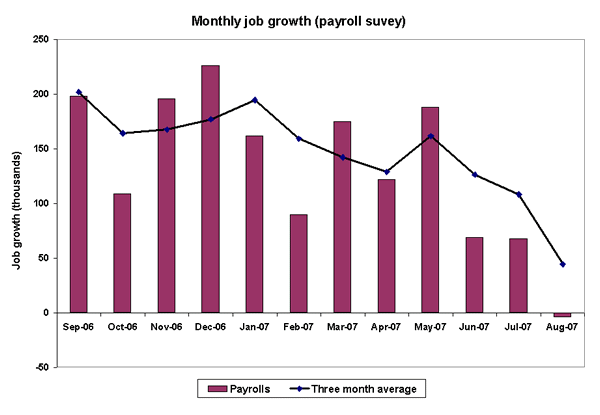September 7, 2007
Job growth hits the wall as financial turmoil hits the jobs market
By Jared Bernstein with research assistance from James Lin
In an unexpectedly and extremely weak employment report from the Bureau of Labor Statistics, the nation’s payrolls shrunk last month, the first monthly decline since August 2003. Prior months’ job gains were revised down by 81,000, leading to an average monthly gain of just 44,000 over the past three months. Such a low monthly rate of job growth provides the first solid evidence that economic turmoil in financial markets has found its way into the job market.

The unemployment rate, calculated from the survey of households, was unchanged at 4.6%, but this was due not to job growth in that concurrent survey. In fact, employment fell 316,000 last month according to the more volatile (and thus less reliable on a monthly basis) household survey. Averaging over the year, that survey shows a monthly decline in jobs of 16,500 so far in 2007.
The reason August’s unemployment rate was unchanged was due to a large monthly fall off—down 340,000—in the labor force (those who leave the labor force are not counted among the unemployed). In other words, the unemployment rate was unchanged due to fewer job seekers, not more jobs. Had those who left the labor force instead been counted as unemployed, the rate would have jumped to 4.85%. (The BLS noted that part of the decline in the labor force was driven by teenagers going back to school, but the adult male labor force, which had been growing in general, also fell by over 100,000.)
Many industries shed jobs or grew slowly in August. The monthly diffusion index, a measure of how many industries are adding jobs, hit its lowest level since February 2004. In an acceleration of an already negative trend, factory employment was down 46,000, the largest monthly loss in that sector since 2003, dispelling hopes that strong exports in the second quarter might help stem these losses. Auto manufacturers made the largest cuts in the factory sector, down 11,000 jobs.
Reflecting the housing market turmoil—including sharply diminished home sales, rising inventories, and falling prices—construction employment fell 22,000, driven largely by a decline in residential contractors. Related losses also occurred among financial institutions that deal with mortgage lending. Putting these sectors together, EPI’s residential index fell by 28,000 jobs in August, and is down 127,000 since April 2006.
Local government was also a big job loser last month, driven by a 32,000 loss in public education. Given that the largest job losses were concentrated in factories, construction, and government, private service-providing industries were net gainers, adding 88,000 jobs last month. However, growth in this sector has also decelerated. On average, private services added 100,000 jobs per month over the past three months, compared to 150,000 per month over the prior 12 months.
The office sector (professional and business services), for example, which is a large, important engine of job growth in the service economy, added only 6,000 jobs in August, largely due to contractions in temporary help, another sign of cyclical hiring weakness.
Health care, however, was up 35,000 jobs and continues to buck any negative trends by steadily adding employment. Restaurants and bars also gained 24,000 jobs, and retail trade added 12,500.
These latter gains in retail and food services suggest consumers are still spending freely in some areas. In fact, on a yearly basis, both hourly and weekly earnings were up 3.9% in August, a solid rate that is likely to beat inflation, barring unforeseen price spikes.
However, if the pervasive weakness in today’s report continues, any wage pressure in the job market will shortly begin to let up, and wage growth will slow. This, in turn, will show up as weaker consumption and ultimately slower overall growth, reinforcing the trend in weak hiring of recent months.
A central question surrounding today’s report was whether it would provide clear evidence of a contagion effect from financial markets. Are the bursting housing bubble, the credit crunch, and recent financial market turmoil having a negative impact on the job market? The BLS report provides an unequivocal “yes” in response to that question. The fingerprints of these problems are all over today’s report. While we cannot draw a firm conclusion based on one month of jobs data, a host of factors point to a new and troubling job market: negative revisions of earlier months’ data, widespread losses and slowdowns across industries, and weak labor force growth.
To view archived editions of JOBS PICTURE, click here.
The Economic Policy Institute JOBS PICTURE is published each month upon release of the Bureau of Labor Statistics’ employment report.
EPI offers same-day analysis of income, price, employment, and other economic data released by U.S. government agencies. For more information, contact EPI at 202-775-8810.
